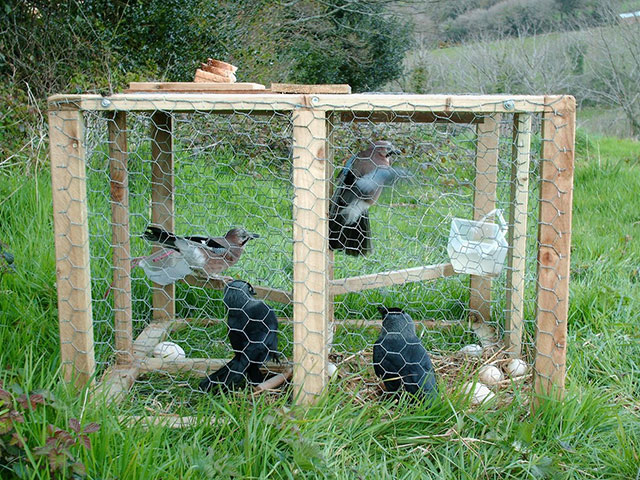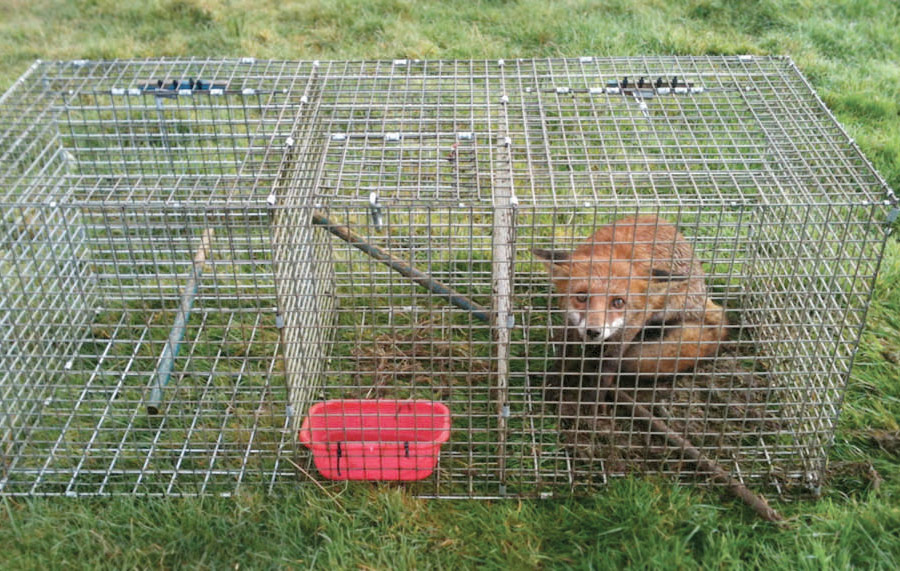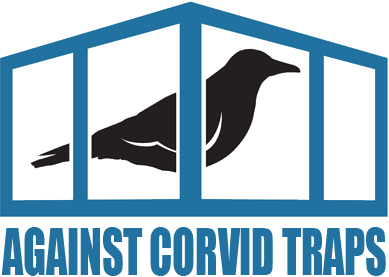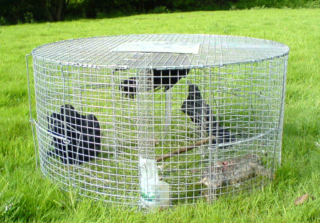Larsen Traps
Larsen traps are wild bird traps that use a live decoy bird, usually a crow or magpie, to lure the target birds. The trap consists of a compartment for the decoy bird and capture compartments for the targetted birds. When the corvid enters the cage, a door closes behind it, preventing its escape.
Due to their inherent cruelty Larsen Traps are banned in many countries, but not in the UK.

Larsen Traps in the UK
Larsen Traps were developed by a Danish gamekeeper, Mogens T. Larsen, in the 1950s, but are now banned in that country because Larsen traps are inhumane for trapping magpies and crows. Other countries that have banned Larsen traps include Austria, Belgium, Finland, France, Germany, Italy, Luxembourg, the Netherlands, Norway, Spain, Sweden, and Switzerland.
Larsen traps have been used in the UK since 1988, following their introduction by the Game Conservancy Trust. As these live bird traps use a captive wild bird, technically contrary to the 1981 Wildlife and Countryside Act, Natural England provided the shooting industry with a loophole by issuing a “Trapping wild birds: standard licence”. Under the terms of this licence only magpies, crows, jays, jackdaws and rooks can be trapped.
Types of Larsen Trap
The traditional Larsen trap is the one conceived by Mogens T. Larsen. It consists of a wooden or wire mesh cage divided into two compartments: the call bird compartment and the capture compartment. The call bird, typically a live decoy, lures other birds into the trap. Once a bird enters the capture compartment, a spring-loaded door shuts behind it, preventing escape.
The multi-catch Larsen trap is an innovative modification of the traditional design. This trap allows for the capture of multiple birds. It features a series of interconnected compartments, with each compartment having its own spring-loaded door. Under the terms of the “standard licence” three Larsen traps are permitted:
- Larsen trap
- Larsen mate trap – also known as a clam trap
- Larsen pod trap
Modern Larsen trap are typically constructed using lightweight materials such as aluminum, making it easily portable to different locations. Larsen traps can be made in a variety of ways with the trap doors being located on the top or side.
Larsen Trap Cruelty
Corvids (members of the crow family that includes the rooks, ravens, magpies, jackdaws, choughs and crows) are the most highly intelligent of birds, with cognitive capacities on a par with the non-human great apes and brains, relative to body size, that are just as big. The Larsen trap represses their most vital instincts, their curiosity and playfulness. It lays them open to great stress and fear from potential predators. It is inhumane and should not be allowed. The hidden nature of the trap on private land leaves them open to neglect and abuse that is unenforceable.
Professor Nicola Clayton, Department of Psychology, University of Cambridge, 2023
Many people who use Larsen traps have an absolute hatred of crows, magpies, jackdaws, jays and rooks. This is typically reflected in their behaviour towards the decoy and captured birds. Decoy birds are regularly injured during their capture and are not treated. Jonathan Darcy, a contributor to UK based internet hunting forum, recommended that “If you shoot enough (magpies) you will find the odd one is a winged…”. We have witnessed numerous decoy bird with their wing feathers cut by gameskeeper to stop the bird from flying if it escaped.
The decoy bird is then placed in a small compartment at floor level with night predators within inches of them. The experience of being trapped in a confined space induces immense fear, anxiety, and psychological distress in magpies, crows and other corvids. These birds are highly intelligent and social, and their natural instincts are thwarted when they are confined within the narrow boundaries of a Larsen trap. The stress and anguish they endure can have a profound impact on the well-being of the decoy bird.
Larsen traps can subject crows, magpies and other corvids to physical injuries upon capture. The abrupt closure of the trap door can cause harm to their wings, legs, or beaks, leading to fractures, dislocations, or severe bruising. The confinement within the trap can exacerbate these injuries and prevent non-target birds from receiving immediate attention. The captured birds with will do everything they can to try and escape and we witnessed many birds with broken beaks and deep cuts on their heads.
Crow and magpies have been left to die without food and water and when it was reported no action was taken against those responsible. Larsen traps, like Ladder traps, are indiscriminate and often trap non-target species such as lambs, cats, pheasants, foxes and, of course, birds of prey.

Who uses Larsen Traps and Why?
Gamekeepers are Larsen traps main users as they claim crows, magpies, etc., might predate on gamebirds. Some mindless and inhumane people set Larsen traps in private gardens. They have usually seen a magpie rob a bird’s nest and set out with vengeance. Research commissioned by the RSPB shows that magpies are not responsible for the decline in songbirds. They fail to realise that dense cover (ivy, thorny bushes, etc.) are the answer to magpie predation in gardens.
When are Larsen Traps used?
They are mainly used in spring and early summer, when birds have their young.
Where are Larsen traps found?
Larsen traps are normally placed near a pheasant pen, or at the edge of a woodland where the pheasant pen is nearby. You could also find them in the corner of a grain field. You will see quad bike tracks where the gamekeeper inspects the Larsen trap from time to time.
How Can We Ban Larsen Traps?
- Write to your local paper and tell people how disgusting and cruel these Larsen traps are.
- Pigeons are sometimes used to attract birds of prey. It is illegal to use a pigeon – if you find one, contact the RSPB immediately.
- Get out there and look for the Larsen traps.
- Video, photograph and help expose the cruelty of trapping crows and magpies.
- Don’t forget that they will be well away from footpaths and bridleways. They will usually be near pheasant pens and in woodlands.




